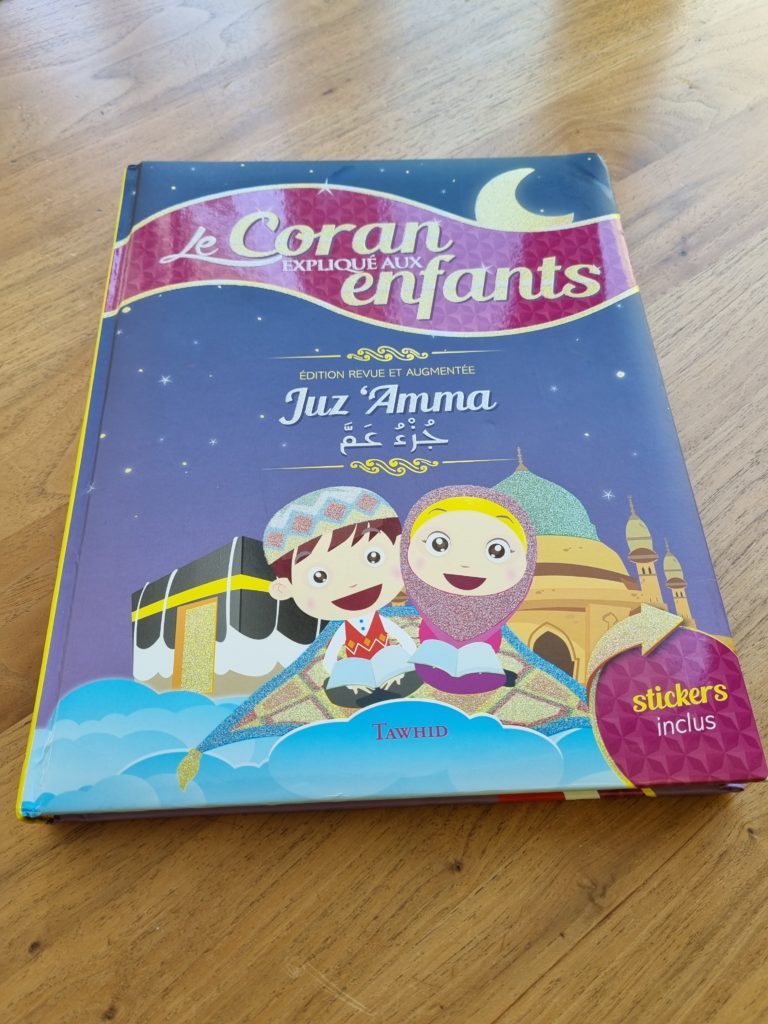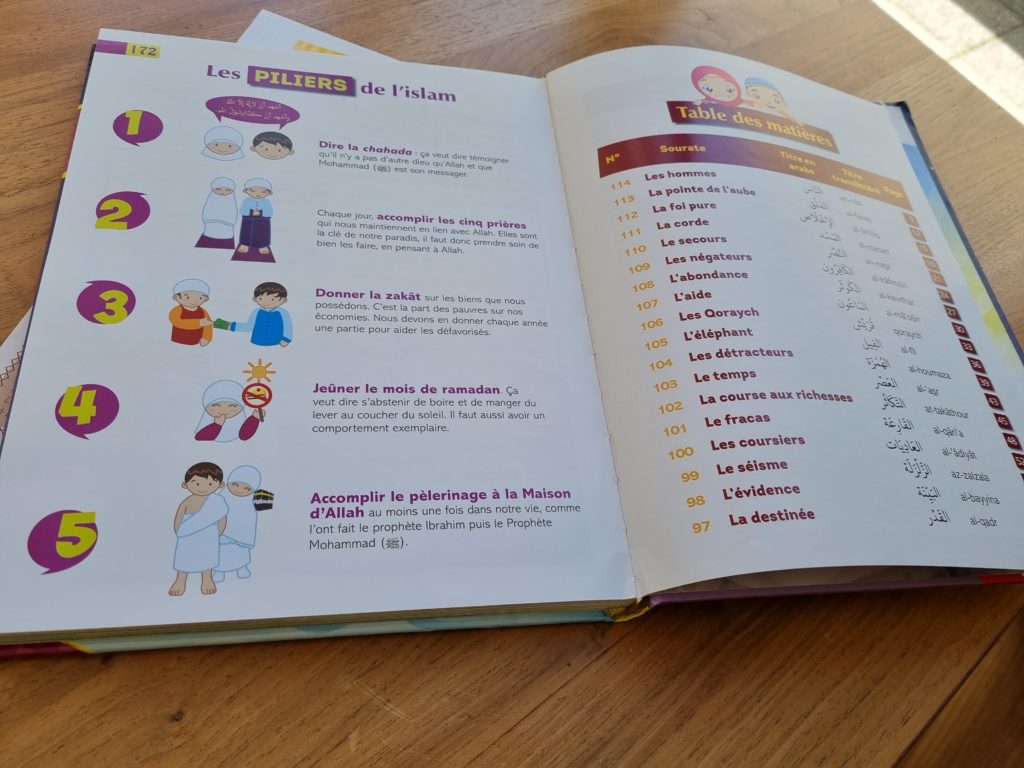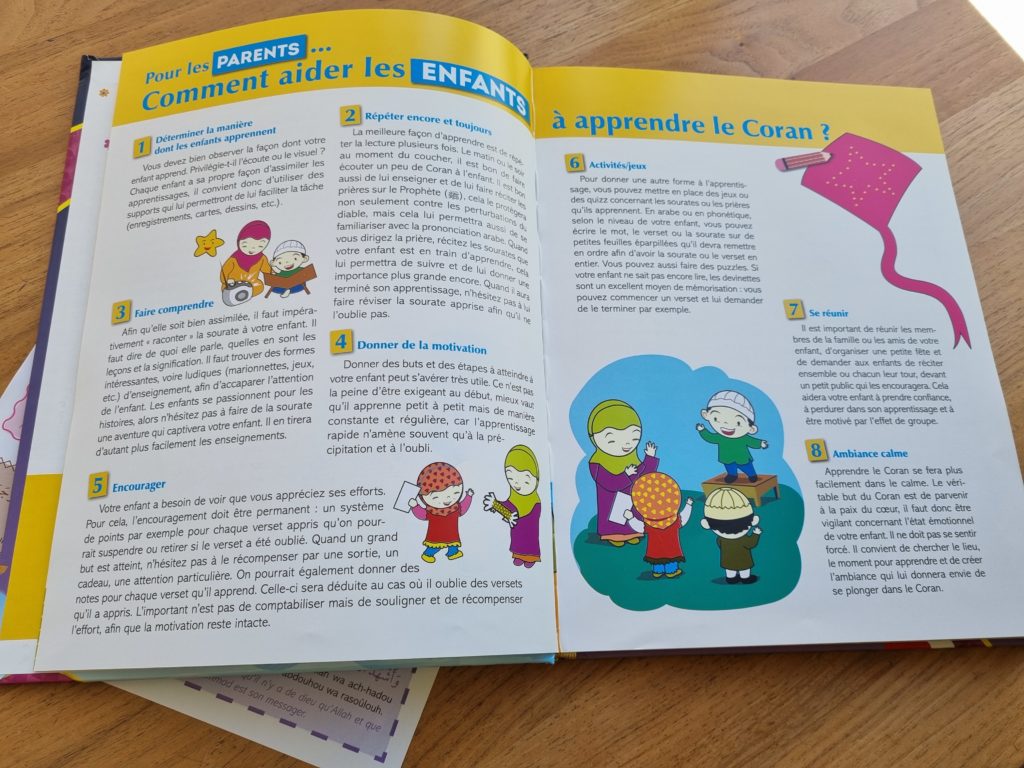Le Coran expliqué aux enfants: Juz ‘Amma is an illustrated French translation and commentary of the Qur’an for children. In many countries, there is a growing market for such books. They may take different forms, ranging from a thematic summary or arrangement of Qur’anic verses to translations of complete suras, often accompanied by additional material.
Le Coran expliqué aux enfants belongs to the latter category. It covers the juzʾ ʿamma, the last of the thirty parts into which the Qur’an has been divided for ritual purposes, containing suras 78 through 114. The juzʾ ʿamma traditionally plays an important part in Qur’anic pedagogy, for a simple reason. Since the suras of the Qur’an are approximately arranged in order of descending length, the juzʾ ʿamma largely consists of very short suras. This makes them easier to memorize than the lengthier suras at the beginning of the Qur’an. Like most books that teach the juzʾ ʿamma to children, Le Coran expliqué aux enfants also contains the first sura, the Fātiḥa, which has only seven verses and is an important part of ritual prayer.
The book is equipped with a thick glossy cover, comes with a sheet of stickers with short prayers, and has colorful, if somewhat generic, illustrations on all pages. All this is based on a book from Malaysia: Al-Quran Kitabku: Ensiklopedia Juz Amma, by Darul Mughni, which is written in the Malay language but also contains an English Qur’an translation.
Translation from one non-Arabic language to another is not an uncommon procedure within the genre of illustrated Qur’ans for children since the translation of existing works saves the need for producing new illustrations. It is more often English than Malay source texts that are translated, though. The French version of Al-Quran Kitabku was published by Éditions Tawhid, a Lyon-based publisher affiliated with the Union des Jeunes Musulmans (U.J.M.), an organization with Muslim Brotherhood leanings. The explanatory texts in Al-Quran Kitabku were translated, with significant adaptions, by Siham Andalouci, a Muslim activist, author of Islamic children’s books, and former associate of Tariq Ramadan.
Le Coran expliqué aux enfants contains an introduction that instructs parents on how to teach the Qur’an to children, namely by providing motivation, offering encouragement, and making the tasks enjoyable, rather than by using a punitive approach. Advice against the latter aspect is emphasized strongly, which conveys the impression that the authors suspect parents of leaning towards the use of punishment.
In the list of steps that parents are encouraged to take to teach the Qur’an to their children, the ability to recite the suras in Arabic is clearly the first goal, after which comes comprehension. The importance of recitation is also apparent from the structure of the book. For each sura, the Arabic text is presented alongside a transcription and French translation. At the bottom of the page is a circle that the children may checkmark when they have finished memorizing the sura.
After the text of the sura comes a commentary that consists of the following elements:
- A short summary of the theme of the sura;
- the occasion of its revelation (sometimes missing when none has been transmitted);
- an explanation of the meaning in a style that children can easily comprehend;
- translations of one or two Arabic key terms such as ʿilm (‘knowledge’) or arḍ (‘Earth’);
- boxes containing questions and answers regarding concepts mentioned in the sura or general religious concepts, such as ‘Who is Pharaoh?’, ‘Who is virtuous?’, ‘What is a prophet?’, ‘What are the five pillars of Islam?’, ‘Having a daughter’, and ‘The miracles of creation’;
- a box with advice and guidance that children should take from each sura such as ‘Do not obsess about money; it is just a means to an end’ or ‘Allah hates those who are arrogant and do not remember him. Thus, think of Allah regularly’.
All in all, it is clear from the make-up of the book that the focus is strongly on ‘take-home guidance’, which matches the publisher’s activist leanings.
The Qur’an translation used in Le Coran expliqué aux enfants is replicated from Mohamed Chiadmi’s, Le Noble Coran. Nouvelle traduction française du sens et de ses versets, which is published by the same publisher, Éditions Tawhid. Chiadmi (b. 1924), a Moroccan teacher and translator who held high positions in the Moroccan Ministry of Education and other political institutions, aimed for a comprehensible translation that is fairly close to the meaning of the source text as he understands it, but also captures some of the poetic qualities of the original.
The problem with using an existing Qur’an translation and integrating it into a larger exegetical work is that the Qur’an translation might not always match the commentary. For example, Chiadmi translates Q 95:1 (wa-l-tīni wa-l-zaytūn; ‘By the fig and the olive!’) as ‘Par le figuier et l’olivier’ (‘By the fig tree and the olive tree’). However, the explanation of the term ‘tīn’ on the page only refers to the fruit (‘figue’), not to the term ‘figuier’ (‘fig tree’). Children who are not familiar with these terms might find this confusing. This is unlikely to be the case in France, though, where figs are ubiquitous. In Malaysia, figs are not typically grown and consumed, which probably explains this piece of information.
In some cases, Andalouci seems to be conscious of the potential conflict between translation and commentary and tries to remedy it. For example, Chiadmi translates Q 112:3, where the Qur’an says about God ‘lam yalid wa-lam yūlad,’ as ‘Il ne naît pas et ne donne pas naissance’ (‘He is not born nor does He give birth’). Many translators prefer to render the verse as ‘He does not beget nor has He been begotten’ since that matches the grammatical gender the Qur’an assigns to God whereas giving birth is usually read as female. One might imagine that Chiadmi’s translation raises questions for children who read it. Therefore, Andalouci’s commentary adds a segment to the Malaysian original in which she explains that God has no parents and no children, thereby de-gendering Chiadmi’s translation.
The commentary on this verse is also one of several instances in which both the translation and the commentary erase religious differences between Islam and Christianity and Judaism, which is one of the striking features of this translation and commentary. Q 112:3 can be read as a commentary on the Christian belief that Jesus is God’s son, and it has been interpreted by many exegetes that way, among other options. However, Chiadmi’s translation, according to which God ‘has not given birth,’ does not exactly suggest this possible meaning (since according to Christian belief, it is Mary who has given birth to Jesus), nor does Andalouci’s commentary which has been added to her translation of the Malay original. In this commentary, she claims that the Arabs of Muhammad’s time had more than 360 Gods but remains silent about any possible reference to Christian beliefs.
With regard to the same sura, the Malaysian source text provides an occasion of revelation, according to which the sura was revealed in reaction to a provocative question by some of Muḥammad’s Jewish adversaries, as part of its commentary. This is missing from the French translation.
In another instance, in the commentary on Q 105 (Sūrat al-Fīl) included in Le Coran expliqué aux enfants, the story of the army of the elephant which King Abraha led from Yemen to Mecca in the year of Muhammad’s birth is told. According to the original narrative from the biographies of the Prophet, the conflict between the Quraysh and Abraha erupted over a monumental church the latter built in Ṣanʿāʾ. However, in Le Coran expliqué aux enfants, the church becomes a ‘temple.’ The Christian identity of Abraha, who is later defeated through divine intervention, becomes invisible.
Another instance in which a reference to Christianity is – probably deliberately – avoided is the commentary on Q 95 (Sūrat al-Tīn). Here, the above-mentioned oath (‘By the fig and the olive!’) is interpreted as a reference to Jerusalem, a ‘land of prophets’. The two subsequent verses are said to represent the prophethood of Moses and Muḥammad, respectively. This interpretation is based on an exegetical tradition that goes back to medieval interreligious polemics; it was put forward by Ibn Taymiyya, among others, and cited in Ibn Kathīr’s Qur’anic commentary. However, in this tradition, the reference to Jerusalem is explicitly understood as indicating the prophethood of Jesus. Le Coran expliqué aux enfants judiciously avoids mentioning this.
We can only speculate about the reasons for which Andalouci was reluctant to mention Christians and, for the most part, Jews. Maybe she wanted to avoid an impression of hostility towards these religions, especially in the French context in which Muslims are a minority. The choice of Chiadmi’s Qur’an translation serves this purpose well, given that he renders the term kāfir, which is often understood to mean ‘unbeliever’ or ‘non-Muslim’, as ‘negateur’ (‘negator’, ‘denier’). Rather than denoting any specific non-Islamic religion, this terminology suggests a state of mind.
It is also possible that Andalouci did not wish to draw attention to the Jewish and Christian context to which the Qur’an frequently refers, thereby emphasizing Islam’s independence of previous monotheistic religions.
All in all, Le Coran expliqué aux enfants is an interesting case study of global networks in Islamic publishing. It also shows how a work that is transferred halfway across the globe can be transformed and adapted to a different local context through translation.
Johanna Pink








